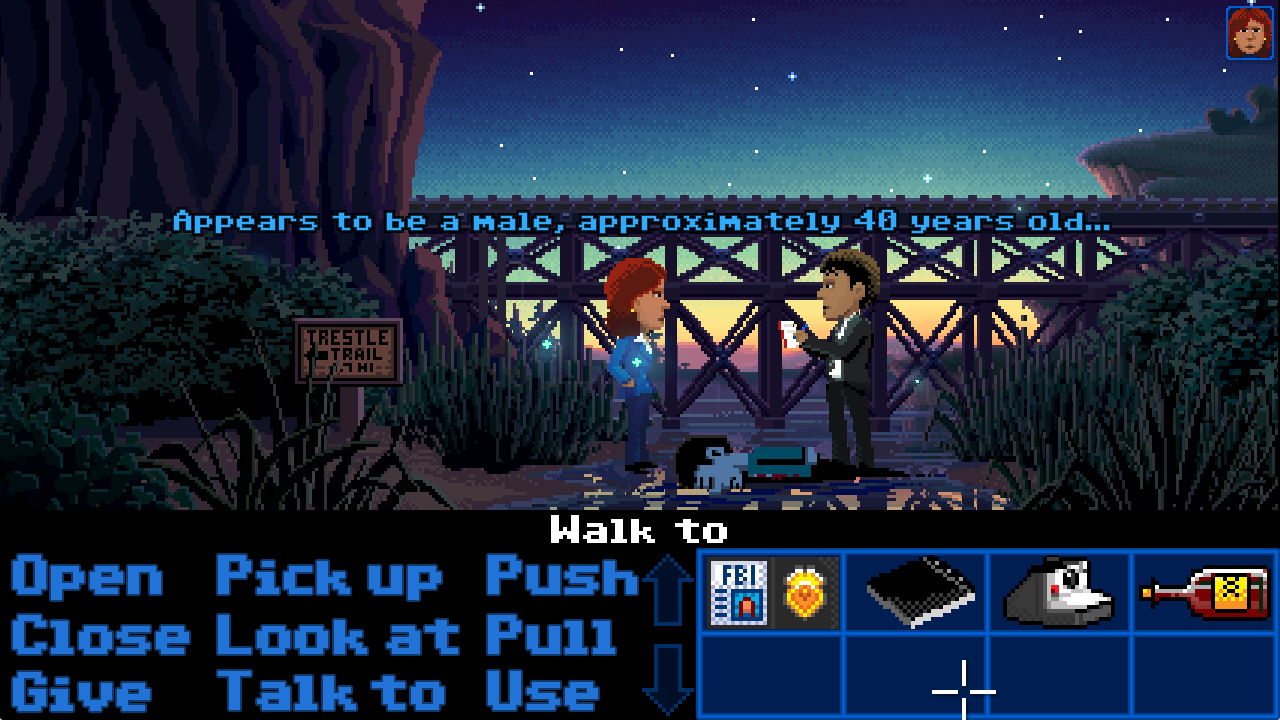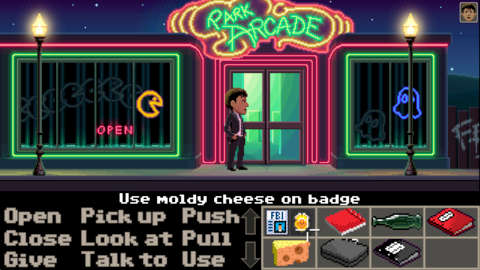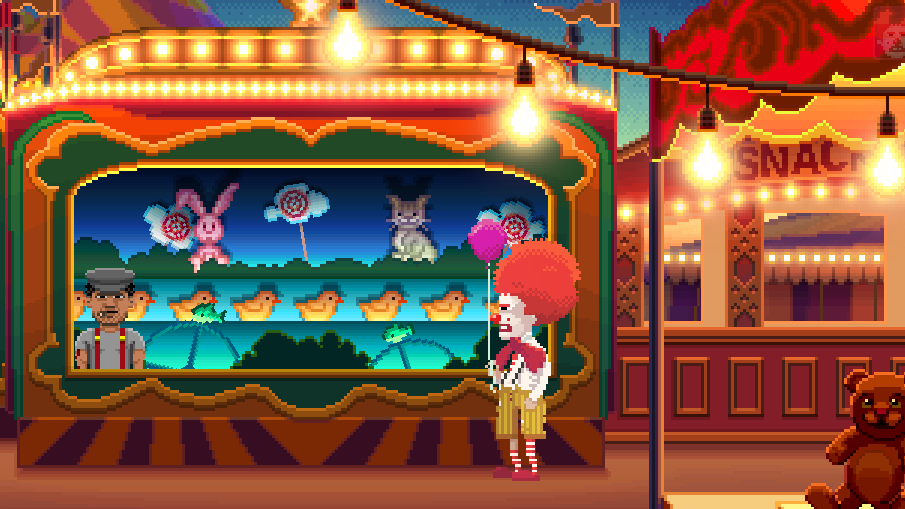One of the first things you do in the colorful, comedic Thimbleweed Park is photograph a corpse. You don't simply point a camera at the body and snap a picture, though--that would be too easy. Thimbleweed Park is a point-and-click adventure game, and a nostalgic one at that. It apes all the mechanics that defined the genre's earliest years, including Maniac Mansion's memorable user interface. So to capture that corpse on film, you must select "use" from the ever-present list of verbs then highlight the camera in your inventory before finally clicking on the body to complete your task.
"Modern adventure games, although they're very good, they're kind of missing that charm that those old games had, and we've always kind of felt this interface was part of that charm," explains designer Ron Gilbert, who masterminded Maniac Mansion, Monkey Island, and a number of other genre-defining adventure games in the late '80s and early '90s. "And it's not just the look but the fact that you [had] verbs and had those choices. There were puzzle-solving opportunities with that, plus there were a lot of humor opportunities."

With its verb-driven puzzles and deliberately retro aesthetic, Thimbleweed is clearly committed to delivering old school charm. At the same time, however, the game won't slavishly recreate every aspect the classic adventure game experience. "We understand that people do approach games a little bit differently today than they did back then," assures Gilbert. "So even though this has this aesthetic of this classic point-and-click thing, we're trying to adjust all of those little design decisions with people's more modern expectations for how things work."
Naturally, some of these design adjustments are relatively minor, while others should ensure the game is actually playable. "When you would asked somebody in [Maniac Mansion] for information, they would tell you and then they would never tell you that information again," explains Gilbert. "We expected players to grab a pencil and a pad and write the information down, and players expected to do that. I think players today don't expect to do that, and so, when you do talk to different characters, they will tell you same things over and over again in different ways."
This theme of preserving players' fond memories by delivering an authentic yet subtly updated experience extended to nearly every facet of my demo. But it all started with a body under a bridge. Though Thimbleweed's narrative eventually encompasses five playable characters, it starts with just two: Agents Ray and Reyes, a pair of washed-up FBI agents sent to the mysterious, decaying town of Thimbleweed to investigate a murder.
It's a straightforward enough premise, but according to Gilbert, the game's grim opening photo shoot is only a precursor to a series of larger mysteries. "What you quickly realize is that it's not really a murder mystery," teases Gilbert. "The body is so unimportant that it actually remains in the river for the entire game. As you are trying to figure out who killed the person under the bridge, you kind of get these new goals, and that especially happens when you start to unlock the characters."
While Gilbert denies Ray and Reyes are anything like their obvious doppelgangers Mulder and Scully--"we were not thinking X-Files at all; it never entered our head"--he does acknowledge David Lynch's Twin Peaks as an influence. Like that series' titular town, Thimbleweed's citizens harbor their own secrets that gradually eclipse the central death that kick-starts the story. And after roughly the first hour or two of gameplay, players can freely swap between five of these characters, all of whom offer their own perspective, personality, and narrative arc.
"I think that's one of the things that interactive storytelling can give us: we're not telling a single linear story," says Gilbert. "When you have multiple characters, you can tell multiple stories. You can complete and solve the main story and never really solve the stories of the characters. Or you can spend time and really go deep into their stories and solve some more puzzles that resolve their whole stories."
Thimbleweed's multiple protagonists also serve a gameplay purpose, one that smoothes a rough edge found in many early adventure games. "I think one of the cardinal sins of adventure games is if there's only one puzzle to solve," asserts Gilbert. "You should always have two or three or four puzzles that you're constantly working on, and then each of those then kind of opens up new branches of puzzles."

If nothing else, Thimbleweed's branching puzzles should keep you from getting stuck, though with five playable characters, five limitless inventories, and an unrestricted world full of objects to scrutinize and fully voiced NPCs to interrogate, Thimbleweed could conceivably become a little overwhelming. Thankfully, the game's early hours are punctuated with playable flashbacks that introduce the five main characters while also easing you into its particular brand of puzzle-solving.
"This is one of the things that we're doing to help people that are maybe new to point-and-click adventures," says Gilbert. "We're putting them in these small, controlled environments where they can kind of slowly get into the puzzles rather than just pushing them into the pool and saying, 'Hey, sink or swim!' Which was how things worked back in Maniac Mansion and Monkey Island. I think players today … want this comfort of knowing that they are heading in the right direction."
During my hands-on time, I explored one of these controlled flashbacks as Ransom, an insult comic clown who was busy preparing for his next performance at the Thimbleweed circus. While Ransom strung together some crass commentary, I searched his trailer for a red clown nose (which I found on a nearby doll), pulled down a poster hiding a safe full of cash, deciphered some hints tacked to a corkboard in order to open the safe, and finally took the cash to a nearby carnie to buy back Ransom's joke book.
In that short span of time, I learned how to apply verbs to objects in the environment, utilize items in my inventory, and engage NPCs with the game's dialogue tree system. As Gilbert described, this one section encapsulated everything I remember about old school adventure games--plus, I got to groove to the jazzy noir soundtrack and cringe at Ransom's abrasive behavior. It wasn't always crystal clear what I could interact with, but in theory, experimenting with the mechanics and discovering random jokes when you fail is half the fun.

"It's all the wonderful, charming things about point-and-click adventures but without all the stupid stuff about point-and-click adventures," jokes Gilbert. "We want this game to really feel like you remember those old games. It's not really how those old games were, because I think we remember those old games being a lot better than they actually were."
Whether Thimbleweed can successfully turn our rose-tinted memories into a modern reality remains to be seen, but you'll be able to decide for yourself when the game launches on Xbox One, PC, Mac, and Linux either this October or next January. According to Gilbert, "We don't want to detract from Call of Duty by releasing [during the holiday rush]."

